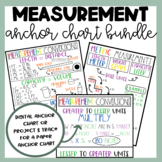Math Anchor Chart | Measurement | Unit Conversions | MD.1 | Digital Anchor Chart
- Zip
Also included in
- Introducing our comprehensive Fourth Grade Math Mega Bundle – your one-stop solution for mastering all the fourth-grade math standards! This bundle combines all the digital step-by-step instruction products from our collection, offering a treasure trove of resources to support your students' math lePrice $63.00Original Price $71.50Save $8.50
- MEASUREMENT AND DATA STANDARDS | MULTIPLICATION | DIVISION | RATIOS | METRIC CONVERSIONS | STANDARD CONVERSIONS | CONVERT USING DIVISION | CONVERT USING MULTIPLICATION | METRIC LADDER | LENGTH CONVERSIONS | CAPACITY CONVERSIONS | WEIGHT CONVERSIONS | TIME CONVERSIONS | 4.MD.1 | FOURTH GRADE MATH | DPrice $7.50Original Price $9.00Save $1.50
Description
MEASUREMENT AND DATA STANDARDS | MULTIPLICATION | DIVISION | RATIOS | 4.MD.1 | FOURTH GRADE MATH | DISTANCE LEARNING RESOURCE
There are 3 anchor charts to fit all the needs of this standard. Check out the MD.1 Bundle option.
This anchor chart aligns with the CCSS 4.MD.1 on how to make conversions between different units of measurement. It gives two examples and two key phrases for students to remember. It demonstrates creating a ratio of the two different unit measurements and then demonstrates how to make that conversion. The examples are with standard units of measurement, but it still applies to metric units.
These digital math anchor charts can be used digitally or you can project them to a wall, SmartBoard, whiteboard, or any flat surface and trace them on to your favorite anchor chart paper. I use a paper poster/anchor chart version to reference when teaching or working in small groups. I also insert the .png file in my presentations for reference.
For ideas, tips, and help with these products, check out my Instagram @shawintheclassroom to find multiple ways to use these anchor charts.
This product comes with a PDF and a .png version to be used as a link in a digital environment.
There is also a large Measurement Bundle that includes all of the Measurement and Data standards for CCSS in 4th grade.




